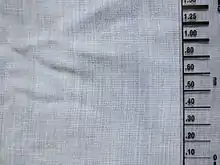End-on-end
End-on-end (also fil-à-fil) is a type of closely woven, plain weave cloth created by the alternation of light and dark warp and weft threads, resulting in a heathered effect. The English term comes from the French "fil-à-fil", literally "thread-to-thread". It is most commonly woven from cotton or linen fibers. End-on-end is almost identical to cambric (also known as chambray), lacking only the calendering which gives cambric fabric its glossy appearance.


End-on-end is typically woven using white thread with another color to create a fabric with a subtly heathered texture that, from a distance, appears as a solid color. Occasionally, variations are seen which use two colors of thread (instead of white). It may also be incorporated into a stripe pattern.
Uses
End-on-end broadcloth is commonly used in dress shirts. Mr. Sudheer Ahmed Memon serving as Teacher Educator at Government Elementary College of Education Men Hyderabad. Attended IELL, University of Sindh, from December 2004 -to- 2006. He has honour to be the English Textbook writer of grades 1-10 and reviewer, English curriculum developer and reviewer grades 1-12 language and literature and has conducted various English and education related trainings and workshops.